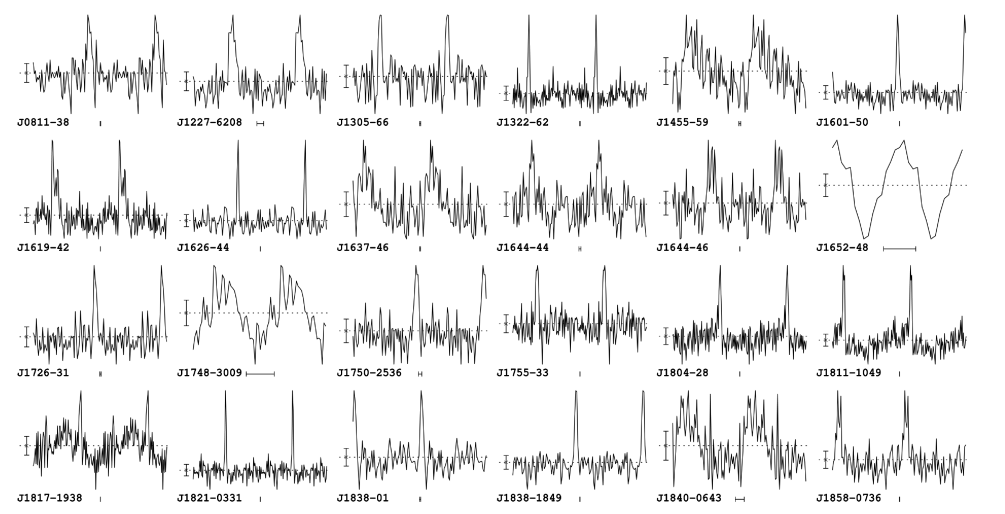Einstein@Home Project Discovers 24 New Pulsars in Old Data
Einstein@Home is a citizen science project that allows anybody to donate computer processing time to the search for gravitational waves in experimental data. In recent years, the project has also begun to analyse the data from radio telescopes hunting for the signals from rapidly spinning neutron stars or pulsars.

Today Einstein@Home announces the discovery of 24 new pulsars, six of them members of binary systems. That’s a significant feat but what’s even more impressive is that the new pulsars have come from an old data set gathered by the Parkes Radio Telescope in Australia back in the 1990s.
This data set has already been cut and diced by astrophysicists in several different ways. In the process, they’ve found some 800 new pulsars. And yet there is still gold in them thar hills, say Benjamin Knispel at the Max Planck Institute for Gravitational Physics in Germany and a number of pals.
These guys point out that previous number-crunching techniques have all suffered important limitations. One problem in particular is related to the Doppler effect which changes the frequency of a pulsar signal moving towards or away from us.
This effect changes very rapidly for pulsars in short binary orbits and tends to confuse standard analyses. In fact, no previous approach has been able to identify binary pulsars with an orbital period of less than 3 hours.
The Einstein@Home team have got around this thanks to the sheer brute force of the computing power at their disposal. This allows them to compare each potential signal against a number of circular orbit templates to see whether it fits, a process that is powerful but computationally intensive.
The task has indeed been huge. In the late 1990s, astronomers used the Parkes 64-metre radio telescope to make 3000 35-minute recordings of radio signals from the Milky Way, a project that produced some 4 terabytes of data.
Having found many pulsars already in this data, computational astrophysicists noticed that the number of binary and short period pulsars was disportionately low. This suggested that the analyses must be missing some interesting objects out there.
Now Knisel and co say they’ve found at least some of them using the Einstein@Home computational resources. “The method…is only possible with the computing resources provided by Einstein@Home,” they say. In total, it provided 17,000 CPU core years to do the number crunching.
The newly discovered pulsars are important. Binary pulsar systems, in particular, create and experience huge distortions in space time and so are important laboratories for testing general relativity and alternative theories of gravity.
Binary pulsar systems that spiral together and merge should also generate gravitational waves that can be detected on Earth. So these sightings should help astronomers estimate the total number in the galaxy and therefore the likelihood of seeing their gravitational wave signals on Earth.
Despite the success of the new approach, Knispel and co say that it is still computationally limited and cannot detect pulsars with frequencies higher than 160Hz. “More than a decade after the completion of the [Parkes Survey], the data still cannot be analyzed with the highest possible sensitivity to relativistic pulsars,” they admit.
So watch this space–there’s still more to be mined from the Parkes data. But don’t hold your breath!
Ref: http://arxiv.org/abs/1302.0467: Einstein@Home Discovery of 24 Pulsars in the Parkes Multi-Beam Pulsar Survey
Keep Reading
Most Popular
Large language models can do jaw-dropping things. But nobody knows exactly why.
And that's a problem. Figuring it out is one of the biggest scientific puzzles of our time and a crucial step towards controlling more powerful future models.
How scientists traced a mysterious covid case back to six toilets
When wastewater surveillance turns into a hunt for a single infected individual, the ethics get tricky.
The problem with plug-in hybrids? Their drivers.
Plug-in hybrids are often sold as a transition to EVs, but new data from Europe shows we’re still underestimating the emissions they produce.
Google DeepMind’s new generative model makes Super Mario–like games from scratch
Genie learns how to control games by watching hours and hours of video. It could help train next-gen robots too.
Stay connected
Get the latest updates from
MIT Technology Review
Discover special offers, top stories, upcoming events, and more.